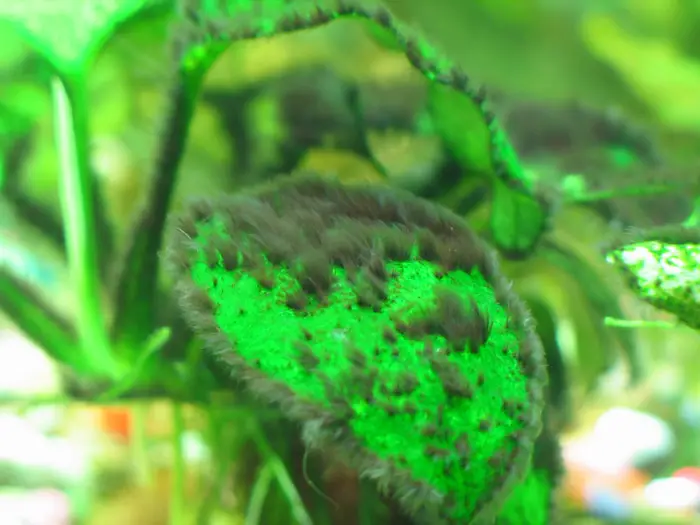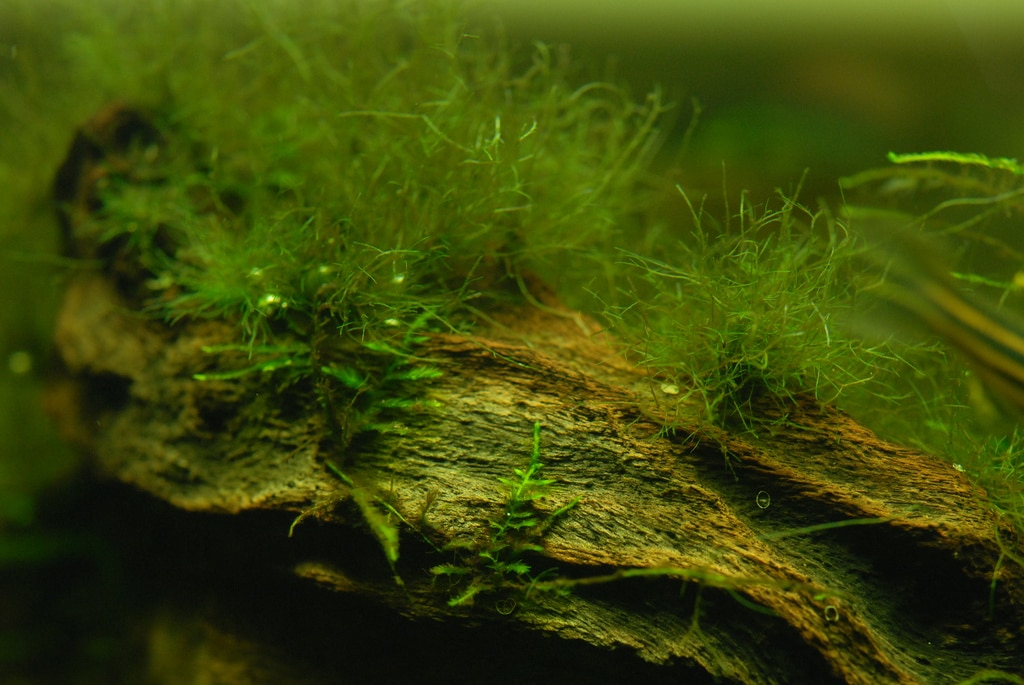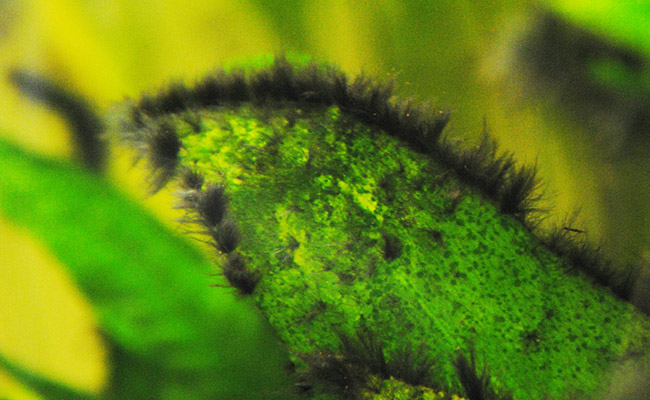Last Updated on July 19, 2021 by Fumipets
Because of its silky, hairy, and slippery appearance, black beard algae is more often referred to as brush algae in the red algae family. This algae develop in dense areas, primarily on tank surfaces and plants in an aquarium.
In contrast to the other red algae families, black beard algae is blackish-green in appearance. Its tenacious nature enables it to adhere to the hard surfaces of the tank or the plants, making manual removal difficult.
Although the algae isn’t inherently detrimental to the majority of your aquarium’s inhabitants, certain fish do eat it. The Siamese Algae Eater and the Florida Flag Fish are examples of this.
How Do You Recognize Black Beard Algae?
Black beard algae seem to be precisely what it sounds like. It begins off as black stubble, but if left unattended, it will grow into a long, flowing black beard. Black brush algae is another name for it, as are its initials, BBA.
The majority of black beard variations are saltwater, although they have been seen in freshwater tanks as well. It’s a very frequent occurrence. If you see alga in your tank, it’s most likely a black beard.
Black beard algae usually begin its existence on the margins of plant leaves before engulfing them entirely.
Staghorn algae is not to be confused with BBA. Staghorn has branching algae strands and a wiry look. BBA, on the other hand, will have single silky smooth strands. The image below depicts a staghorn, which at first glance seems to be identical, but closer examination reveals a distinct structure.

What Causes Black Beard Algae?
Contaminated plants, décor objects, or substrates put into the aquarium are the main source of a black beard infestation. When combined with an aquarium with low carbon dioxide levels and too much light, black beard algae will grow out of control.
Black beard algae can rapidly take over any surface it can get its hands on if left uncontrolled. It’s also worth noting that beard algae spread more quickly in neglected aquariums.
Aquarium caretakers should make frequent water changes and ensure that the tank is balanced in terms of light, nutrition, and carbon dioxide levels. By ensuring this, any undesirable algae breeding environment will be eliminated.
Carbon Dioxide (CO2) and Black Algae
Unstable CO2 levels are one of the most common reasons for uncontrolled black beard algae growth.
If your aquarium’s water circulation is poor, or your CO2 levels are low or vary, you’re creating an ideal habitat for algae development.
The most important thing you can do for your aquarium is to add enough C02 to get it to the right level. If you’re utilising injected C02, it’s possible that your canister is empty or that you’re not injecting enough.
However, if you don’t have a C02 injector, you may need to look at other options for getting more C02. A significant water change may have a significant effect on your C02 level, thus this might have been the cause of the black beard epidemic in your tank.
If this is your present scenario and you have a live plant tank, I recommend adding liquid carbon. I’ve tried a few other kinds, but Seachem Flourish Excel remains the finest I’ve found.
It’s a kind of “liquid carbon” that can be easily added to any aquarium. While it won’t necessarily increase carbon levels in your tank by a significant amount, it does work against algae, and I’ve used it to remove black beard algae effectively.

To Much Light Is Bad
Almost everything that lives in an aquarium enjoys the light, but algae probably enjoy it the most. Once algae get a foot in the door, the more light you have in your aquarium and the longer it is on, the quicker it will spread throughout your tank.
If you prefer to keep live aquarium plants, that fancy grows light is not only assisting your plants in growing, but it is also assisting the algae growth.
If you never turn off your aquarium lights (which happens), or if you keep them on from dawn to dark, you’re encouraging algae to colonise your tank.
Black beard algae may be stopped in its tracks and even killed by reducing the amount of time your aquarium light is on or even turning it off for a few days.
To effectively control the time your lights are on, I recommend using an automated timer. If you want to manage your lights manually, you’ll find it’s quite simple to make errors. If you utilise a timer, you must be very conscientious about turning on and off your aquarium lights.
Aquarium timers are reasonably priced and may save you a lot of time and money, so they’re worth investigating. This one appeals to me.
Is it Possible for Black Beard Algae to Harm Your Fish?
The short answer is no, black beard algae will not damage your fish, shrimp, or snails in your aquarium.
Although the unpleasant black material adhering to all of your plants and surfaces is not dangerous, it is unattractive. Furthermore, because of its tenacity, it is quite likely to spread throughout the aquarium and cover the whole tank if left uncontrolled.
This may lead to nutritional imbalances and a potentially dangerous environment for your fish. The tank will eventually become more difficult to maintain and clean, perhaps resulting in higher amounts of hazardous chemicals. As the algae take over the aquarium and reduce the amount of living area, your fish will eventually suffer.
Is it Possible for Black Beard Algae to Harm Your Aquarium Plants?
The presence of beard algae in your aquarium, on the other hand, may destroy any plants in your tank.
The algae will not immediately harm your plants, nor will it produce poisons or drain nutrients from them. Instead, it’s gradual suffocation.
It’s not a huge issue if you see a speck of black beard algae. It’s a different storey when the algae begin to blanket the whole plant.
Your plants will be unable to photosynthesize, which will be detrimental to their health. Furthermore, there will be more competition for nutrients.
Both of these things will combine to cause your plants to perish.
How to Get Rid Of Any Black Beard Algae in an Aquarium
Black beard algae is an unsightly and sticky annoyance that is almost difficult to remove by hand. Thankfully, there are many ways we may use to permanently remove black beard algae from our tanks.
So, how can you remove black beard algae from your aquarium? There are a few ways to get rid of black beard algae. Using 3 percent hydrogen peroxide (10 ml per 50 litres) is one of the simplest and most effective methods (15 gallons). Add once a day for three days and keep an eye on the black algae until it dies.
Read on to discover alternate techniques and additional information on prevention and identification.
Treat Black Beard Algae With A Hydrogen Peroxide (H2O2) Bath
Hydrogen peroxide is a commonly accessible over-the-counter product (only use 3 percent). This chemical should be kept on hand by aquarium owners to cure a variety of ailments that may afflict the tank’s occupants.
To get the hydrogen peroxide to operate, you should fully immerse any damaged décor or plants (living or fake) in undiluted 3 percent hydrogen peroxide for three minutes.
After the goods have soaked for a sufficient amount of time, thoroughly rinse them in freshwater. As long as you can remove any damaged objects from the tank, this is a simple process.
If you are unable to remove all of the objects impacted by the algae outbreak, you may need to combine this technique with any of the other ways mentioned below.
Treating A Tank With Hydrogen Peroxide
If removing all of the damaged objects from your tank to treat them individually isn’t feasible, try treating the whole tank instead.
Using this technique, I was able to eradicate a black beard algae infestation in less than 14 days. Although the tank was not mine, we were able to accomplish it without harming any of the fish.
In 15 litres of aquarium water, we used 10 mL of neat 3 percent hydrogen peroxide. For example, a 15-gallon tank would need 10mls, whereas a 30-gallon tank would require 20mls, and so on.
Directly into your aquarium, in a location with lots of water movement, add the necessary quantity of Hydrogen Peroxide. Wait three days after doing this once a day.
The black beard algae should start to change colour and disappear after a few days. After a month, the algae should be totally dead. If it hasn’t, you may need to try again with a larger dose.
Your plants may fade somewhat throughout this procedure, but they should be unharmed otherwise.
Fish, shrimp, and snails, as well as the rest of your aquarium’s occupants, should be unharmed. If you’re concerned about their safety, relocate them to a different temporary holding tank while you deal with the algae problem.

Regulating Phosphate (PO4) In Your Aquarium
Decomposed chemicals in your aquarium produce phosphates, which aid algal reproduction. These chemicals may be found in your plants’ waste (dead leaves), fish faeces, or any other organic waste.
Furthermore, if you give your fish too much food, the leftovers may rot and produce phosphates.
When faced with such scenarios, an aquarium keeper may avoid problems by keeping the tank clean.
As soon as possible, remove any dead plant debris.
Remove any dead fish, snails, or shrimp from the aquarium.
Don’t overfeed your fish.
Change the water on a regular basis.
A good aquarium filter will also help you keep the phosphate levels in your tank under control. When choosing a filter, make sure it has adequate water flow for the size of your tank, and keep in mind that helpful bacteria need time to develop.
Introduce Black Beard Algae Eaters
Black beard algae may be eaten by certain fish, shrimp, and snails. While they may not be sufficient to eliminate a significant quantity of algae, they may aid in its management in the first place.
To prevent the algae from taking over, we suggest trying some of the following:
- Siamese Algae Eaters
- Florida Flag Fish
- Amano Shrimp
- Cherry Shrimp
- Ramshorn Snails
Keep in mind that many of these species will only consume algae if there isn’t anything else available. So, if you’re overfeeding your fish, all of the above are far more likely to eat the fish flakes rather than the algae if you’re overfeeding them.
Increase the amount of carbon dioxide in the aquarium
Although carbon dioxide does not destroy black beard algae directly, it does assist to decrease its prevalence indirectly.
CO2 promotes plant development, which decreases the amount of available nutrients in the tank for algae growth. In essence, you’re enabling your plants to outcompete algae development. This technique is unlikely to work if your aquarium does not include living plants.
There are a few ways to raise CO2 levels in a tank:
CO2 Injection
There are many devices available that will enable us to directly inject and disperse carbon dioxide into the tank. These may vary in price from $10 aerosols to hundreds of dollars for pressurised cylinders.
You may also be interested in: Can I Keep a Turtle in My Fish Tank? What You Should Think About
To get a better understanding of which kind of CO2 injector will work best for your tank and your budget, see our article on CO2 injectors.
Seachem Flourish Excel (Liquid Carbon)
When compared to CO2 gas, Seachem Flourish Excel kills algae in a somewhat different way. It includes Glutaraldehyde, which is a kind of pesticide that kills black beard algae directly.
It can and will kill your tank plants, fish, snails, and shrimp in big enough amounts, so always read the label and don’t overload your tank.
I’ve had excellent success treating black beard algae with Flourish Excel. Its capacity to raise CO2 levels in a tank, however, is disputed. However, this is perhaps a topic for another day.

Use Heat Treatment
If you want to avoid using chemicals to fight black beard algae, heat is a viable alternative.
You’ll boil any decorations or fake plants that have been infected with algae. This should go without saying, but just to be sure, this will not work with live plants!
As many algae-covered objects as possible should be removed and placed in a pot. Alternatively, you may pour boiling water over everything and let it cool. Alternatively, you may boil everything for 10 minutes on the stove, which should be enough time to kill everything alive.
If you have plastic plants, cooking them on the stove is probably not a good idea. Any ceramic objects, on the other hand, should be alright.
Boiling stones should be avoided since porous rocks may erupt when heated.
How to Prevent Beard Algae
Of course, prevention is preferable to treatment. Rather than going to extremes to get rid of algae, I’d rather take some steps to prevent it from growing.
Furthermore, if you’ve had beard algae in your aquarium before, your chances of getting it again are greater. Not only may the methods below be used to avoid black beard algae outbreaks, but they can also be used to prevent other types of algae outbreaks.
New fish should be quarantined, and the water they arrived in should not be mixed with the water in your tank. This is most efficient in preventing illness and parasites, although it may also reduce the likelihood of some algae species being introduced into your tank.
Using a hydrogen peroxide soak, clean fresh plants. We understand how exciting it may be to add a new plant to your aquarium. However, before introducing any new plants, we highly advise treating them with a hydrogen peroxide bath. This will assist to keep algae and a variety of other pests and illnesses at bay.
Use only plants and fish from trustworthy retailers. Most fish shops will have policies and procedures in place to prevent hitchhikers from being transferred to client tanks.
Plants and animals should never be taken from the wild. Not only would it be bad for the environment, but you never know what lurks in or on them.
Keep an eye on your light levels and don’t leave your lights on for too long. Black beard algae will nearly always grow in areas where there is a lot of light.
Plant living plants to compete for nutrients with black beard algae. This is beneficial not only to the health of your fish and the plant environment, but it may also help to avoid algae development.
Replace the water in your aquarium on a regular basis. Every 1–2 weeks, you should replace 10–30% of the water in your aquarium. If you aren’t already doing so, you should get started right now.
Make sure the filter you’re using is strong enough for your aquarium. A filter will assist control phosphate levels by ensuring an adequate flow of water around your tank. Regardless of the kind or size of aquarium you have, it is a necessity.
Increase your carb intake. If you don’t want to add pasta to your aquarium, make sure it has adequate CO2. Black beard algae can be combated using Seachem Excel, and it’s much better if used as a preventive.


















